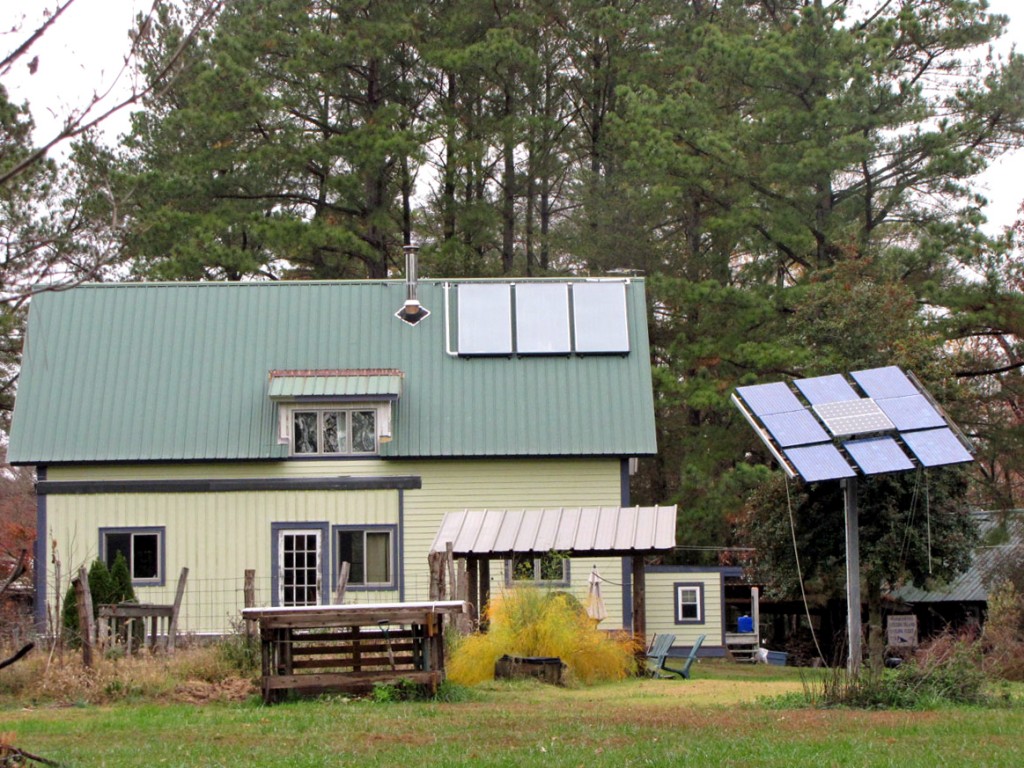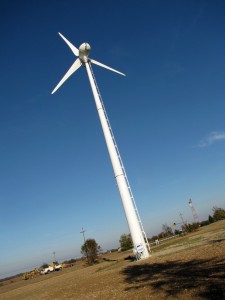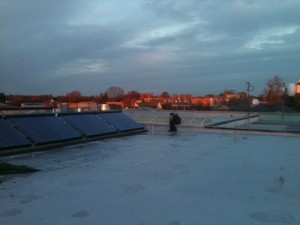Sun and wind: two simple, natural forces. From the sun shining on Talbot County’s 100,000 acres of farmland, to the wind pushing skipjacks across oyster bars, these sustainable and renewable resources have always powered the local economy.
Thanks to a perfect storm of the Great Recession of 2008 and President Obama’s subsequent stimulus plan known as the American Reinvestment and Recovery Act, and Governor O’Malley’s jobs and renewable energy initiatives, residents on the Shore have seen solar and wind projects pop up in increasing numbers since 2009.
In Talbot County, officials have worked to efficiently leverage state and federal incentives for renewable energy for municipal projects, and county residents can see evidence of that effort around the region, says County Engineer Ray Clark.
The Klondike Road wind and solar facility off Cordova Road, built in 2010, is an example. It generates $30,000 a year for the county, and another $60,000 to $100,000 a year in renewable energy credits. Three 100 kilowatt wind turbines and a 300 kilowatt solar array provide energy to county facilities, with excess energy then going to the electric grid. The system was built using $3.9 million in federal and state grant funds and functions as a demonstration project, showing how partnerships can create sustainable systems.
The Maryland Energy Administration’s Project Sunburst – funded through stimulus money – partners with local governments to install renewable energy systems on public buildings throughout the state. Out of 17 different statewide organizations applying for these grants, Talbot County is second only to the City of Baltimore in funds awarded through this program. Baltimore was awarded $900,000 in grant funds, and Talbot County received $890,000 – the only Eastern Shore County that was awarded funds through this program.
One of Project Sunburst’s largest projects to date has been the 550 kilowatt solar array for the Talbot County Community Center on Route 50 north of Easton. It is expected to reduce the Center’s electricity use by 50 percent. And last month, Aurora Energy completed a solar hot water project on the roof of the Talbot County Detention Center.
Other Shore counties are negotiating contracts with electricity suppliers to build and provide solar power to schools and government buildings. Maryland is one of 24 states with a regulation requiring electricity providers to obtain a portion of power from renewable resources within set deadlines. Maryland’s policy calls for 20 percent of its energy to come from renewable resources by the year 2022. A law passed in 2008, requires that per capita energy consumption and demand be cut by 15 percent by 2015.
Energy suppliers can meet state regulations by capturing Renewable Energy Certificates or by creating their own solar assets. Earlier this month, Kent County signed a 20 year contract with Washington Gas Energy Services (WGES) to build a 1,579 kilowatt solar array to power two schools and the Kent County Community Center. The system will be installed by Standard Solar and will be owned and operated by WGES. These same companies also approached Caroline County earlier this week, with a proposal for an array of solar panels on Caroline County.
Caroline County Administrator Ken Decker said that “our citizens want us to be environmentally responsible. Caroline County’s biggest energy users are schools, and we have grounds available for projects like this. Our Board of Education is on the cutting edge of energy management systems and we’ll be looking closely at a partnership like the one in Kent.”
In Queen Anne County, along Route 50 at Chesapeake College, a 50 kilowatt wind turbine was installed by ATech in September. The power generated feeds directly into the Higher Education Center, and is expected to provide energy savings to the College of between $12,000 and $15,000 each year.
“Most counties in Maryland have been looking at various renewable energy options”, said Les Knapp, Associate Director of the Maryland Association of Counties. “Wind has some zoning challenges and larger wind installations can have environmental impacts. Passive solar systems tend to be easier for counties to implement, especially in densely populated areas”.
On the horizon, a 500 to 550 kilowatt solar array is in process the waste-water treatment plant in St. Michaels. And Tilghman Island residents met recently to get information on a possible 50 kilowatt wind turbine to be placed at the waste-water treatment plant. The plant would stabilize sewer rates to homes served by the plant.
The turbine proposed for Tilghman Island would be similar to the one along Route 50 at Chesapeake College.
And as far as Tim Fluharty is concerned, the project just makes sense.
“Tilghman’s location is perfect to take advantage of the wind,” Fluharty explains.
Fluharty has been working with wind energy projects on the shore since the late 1970s. He’s constructed 22 projects ranging from small, single-residential units to large-scale projects such the Chesapeake College turbine. Known as the “go-to guy” for wind in the region, Fluharty has consulted on residential and commercial projects, and has assisted Maryland counties in drafting ordinances governing wind and renewable energy.
A big fan of the newer, hybrid systems that combine wind and solar in a single unit, Fluharty shows a slide presentation of wind projects of every size. Residential hybrid systems offer the best of both worlds, and can reduce a home energy bill by 20 percent. He says solar systems typically take about eight years before they pay for themselves. Wind systems take longer, from nine to 15 years. But after that, all the energy generated is free. Many systems are guaranteed for 20 to 25 years, and can last up to 40 years.
Looking at some photographs of large industrial systems across mountaintops, Fluharty says that in those cases, one turbine can generate enough power for 1,500 to 1,800 households. And he showed a wind map of the United States, saying that there’s plenty of wind in this country to not only provide power, but displace significant amounts of carbon pollution in the air.
But the big news about wind for the Shore is down in Crisfield. Uniquely positioned with some of the best opportunities for wind power anywhere, Fluharty claims that wind power can and will transform Crisfield’s economy. He says that there is a group working right now on that very thing – “wind will not only turn around Crisfield’s economy, but make it a tourist attraction as well.”
With specific goals and timetables set, and encompassing wind, solar, hydro and geothermal energy sources, Marylanders can expect to see more renewable energy on the Shore in years to come.







Write a Letter to the Editor on this Article
We encourage readers to offer their point of view on this article by submitting the following form. Editing is sometimes necessary and is done at the discretion of the editorial staff.